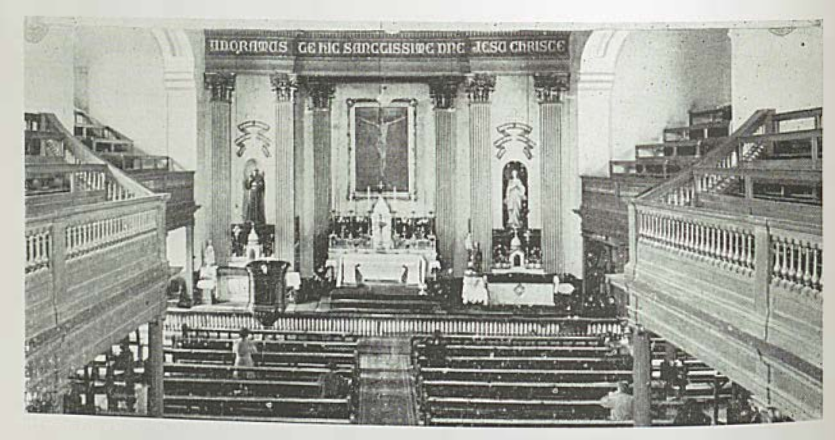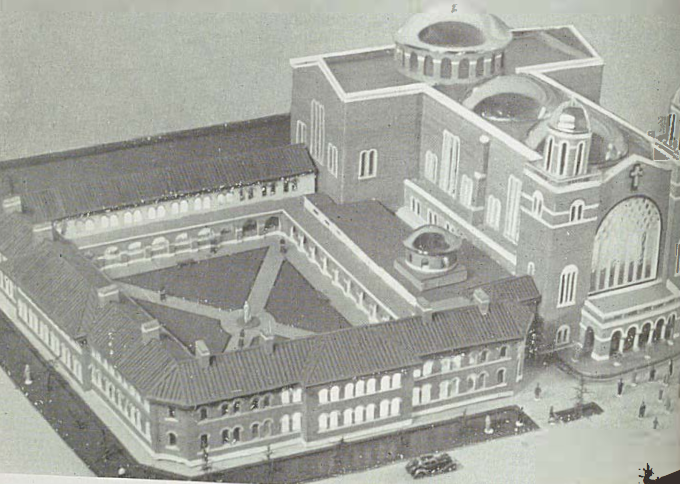Beggars and Artisans: A Cultural History of Cork’s Franciscan Friary / From Assisi to Cork: Architecture of the Modern Church of St Francis
- Elaine Harrington
- May 27, 2021
Student Exhibition, MA in Medieval History
Beggars and Artisans: Architecture of the Modern Church of St Francis
Nearly four hundred years after the dissolution of the monasteries, the Franciscans in Cork saw the opening of their new church in the city centre. Father Jerome O’Callaghan wrote in Franciscan Cork: A Souvenir of St. Francis Church, Cork: ‘Long expected was the great day; it came – the day of the blessing and opening of the new St. Francis.’ This ‘great day’ took place on 14 July 1953. O’Callaghan continues: ‘We may well call the event an epoch-making event. It is the third ‘permanent’ church of the Order to be built in Cork.’ The first Franciscan house in Cork was the medieval friary discussed in the previous post, the second house was the so-called Old St Francis on Broad Lane, and the third the present-day church.

The opening of the Church was hailed as an event of great importance for Cork city.

O’Callaghan’s description of the completed 1953 church encapsulates a sense of awe and wonderment, not dissimilar to the views of medieval western writers towards ecclesiastical architecture. O’Callaghan states that anybody seeing the church was ‘struck by this immense lofty building of rustic red brick which dominates the surrounding areas. (…) The large dominating tracery window, the artistic portico and graceful flanking towers, invest the whole scene in dignified grandeur.’ His selection of words recalls an account of churches in England, France and Italy that were visited by an early fourteenth-century Franciscan pilgrim from Ireland, Friar Simon. Simon, for example, mentions a ‘wonderfully beautiful’ church in Amiens, the ‘glittering’ shrine of Thomas Becket in Canterbury and the Church of Notre Dame in Paris ‘furnished with lofty towers’.

The façade of St Francis Church is flanked by two towers and adorned with a large stained-glass window, above which is the life-size replica of the famous San Damiano Cross. The cross seems to crown the entrance to the church and is a reminder of a seminal story in the life of St Francis. Bonaventure’s (c. 1217-1274) Life of St Francis also known as the Legenda Maior, recounts a time when Francis, still a merchant, visited the San Damiano church outside Assisi. There, he heard a voice speaking to him from the painted cross. According to Bonaventure, the voice told Francis ‘go and repair my house which, as you see, is all being destroyed.’ The use of this particular image on the façade of Cork’s friary alludes to the Franciscan ideals of spiritual renewal and restoration, as well as the actual act of building a church.

‘On reaching the church proper the impression we receive, is one of beauty, dignity and even grandeur.’ It is clear from O’Callaghan’s words that the interior of the church building was planned to reflect the grandeur and wonder of the building’s exterior. Mosaics and stained-glass windows adorn the walls of the church and will be examined in the following sections of this exhibition.
To finish this post, we may quote again from Father O’Callaghan’s Franciscan Cork, in order to convey the impression, which the church left on its visitors in 1953: ‘Almost invariably one hears a first-time visitor uttering the spontaneous whisper: “Oh how beautiful!” and beautiful it is indeed in every line and feature.’
Morgan Hole
Further reading
Bonaventure, The Major Legend of Saint Francis, in Regis J. Armstrong, J.A. Wayne Hellmann and William J. Short, eds, Francis of Assisi: Early Documents, vol.2 (New York, 2000), 525-683.
Esposito, Mario, ed. and trans., Itinerarium Symonis Semeonis ab Hybernia ad Terram Sanctam (Dublin, 1960).
O’Callaghan, Jerome, Franciscan Cork: A Souvenir of St. Francis Church Cork (Killiney, 1953).
St Francis Church: An Illustrated Guide (Cork, 1961).


